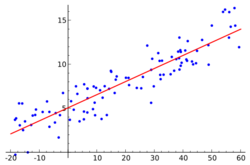Ordered logit
| Part of a series on |
| Regression analysis |
|---|
 |
| Models |
| Estimation |
| Background |
|
|
In statistics, the ordered logit model (also ordered logistic regression or proportional odds model) is an ordinal regression model—that is, a regression model for ordinal dependent variables—first considered by Peter McCullagh.[1] For example, if one question on a survey is to be answered by a choice among "poor", "fair", "good", "very good" and "excellent", and the purpose of the analysis is to see how well that response can be predicted by the responses to other questions, some of which may be quantitative, then ordered logistic regression may be used. It can be thought of as an extension of the logistic regression model that applies to dichotomous dependent variables, allowing for more than two (ordered) response categories.
The model and the proportional odds assumption
The model only applies to data that meet the proportional odds assumption, the meaning of which can be exemplified as follows. Suppose there are five outcomes: "poor", "fair", "good", "very good", and "excellent". We assume that the probabilities of these outcomes are given by p1(x), p2(x), p3(x), p4(x), p5(x), all of which are functions of some independent variable(s) x. Then, for a fixed value of x, the logarithms of the odds (not the logarithms of the probabilities) of answering in certain ways are:
- [math]\displaystyle{ \begin{array}{rll} \text{poor}: & \log\frac{p_1(x)}{p_2(x)+p_3(x)+p_4(x)+p_5(x)}, \\[8pt] \text{poor or fair}: & \log\frac{p_1(x)+p_2(x)}{p_3(x)+p_4(x)+p_5(x)}, \\[8pt] \text{poor, fair, or good}: & \log\frac{p_1(x)+p_2(x)+p_3(x)}{p_4(x)+p_5(x)}, \\[8pt] \text{poor, fair, good, or very good}: & \log\frac{p_1(x)+p_2(x)+p_3(x)+p_4(x)}{p_5(x)} \end{array} }[/math]
The proportional odds assumption states that the numbers added to each of these logarithms to get the next are the same regardless of x. In other words, the difference between the logarithm of the odds of having poor or fair health minus the logarithm of having poor health is the same regardless of x; similarly, the logarithm of the odds of having poor, fair, or good health minus the logarithm of having poor or fair health is the same regardless of x; etc.[2]
Examples of multiple-ordered response categories include bond ratings, opinion surveys with responses ranging from "strongly agree" to "strongly disagree," levels of state spending on government programs (high, medium, or low), the level of insurance coverage chosen (none, partial, or full), and employment status (not employed, employed part-time, or fully employed).[3]
Ordered logit can be derived from a latent-variable model, similar to the one from which binary logistic regression can be derived. Suppose the underlying process to be characterized is
- [math]\displaystyle{ y^{*} = \mathbf{x}^{\mathsf{T}} \beta + \varepsilon, \, }[/math]
where [math]\displaystyle{ y^{*} }[/math] is an unobserved dependent variable (perhaps the exact level of agreement with the statement proposed by the pollster); [math]\displaystyle{ \mathbf{x} }[/math] is the vector of independent variables; [math]\displaystyle{ \varepsilon }[/math] is the error term, assumed to follow a standard logistic distribution; and [math]\displaystyle{ \beta }[/math] is the vector of regression coefficients which we wish to estimate. Further suppose that while we cannot observe [math]\displaystyle{ y^{*} }[/math], we instead can only observe the categories of response
- [math]\displaystyle{ y= \begin{cases} 0 & \text{if } y^* \le \mu_1, \\ 1 & \text{if } \mu_1\lt y^* \le \mu_2, \\ 2 & \text{if } \mu_2 \lt y^* \le \mu_3, \\ \vdots \\ N & \text{if } \mu_{N} \lt y^* \end{cases} }[/math]
where the parameters [math]\displaystyle{ \mu_i }[/math] are the externally imposed endpoints of the observable categories. Then the ordered logit technique will use the observations on y, which are a form of censored data on y*, to fit the parameter vector [math]\displaystyle{ \beta }[/math].
Estimation
For details on how the equation is estimated, see the article Ordinal regression.
See also
- Multinomial logit
- Multinomial probit
- Ordered probit
References
- ↑ McCullagh, Peter (1980). "Regression Models for Ordinal Data". Journal of the Royal Statistical Society. Series B (Methodological) 42 (2): 109–142.
- ↑ "rologit.pdf". Stata. https://www.stata.com/manuals/rologit.pdf.
- ↑ Greene, William H. (2012). Econometric Analysis (Seventh ed.). Boston: Pearson Education. pp. 824–827. ISBN 978-0-273-75356-8.
Further reading
- Gelman, Andrew; Hill, Jennifer (2007). Data Analysis Using Regression and Multilevel/Hierarchical Models. New York: Cambridge University Press. pp. 119–124. ISBN 978-0-521-68689-1. https://books.google.com/books?id=lV3DIdV0F9AC&pg=PA119.
- Hardin, James; Hilbe, Joseph (2007). Generalized Linear Models and Extensions (2nd ed.). College Station: Stata Press. ISBN 978-1-59718-014-6.
- Woodward, Mark (2005). Epidemiology: Study Design and Data Analysis (2nd ed.). Chapman & Hall/CRC. ISBN 978-1-58488-415-6. https://archive.org/details/epidemiologystud0000wood.
- Wooldridge, Jeffrey (2010). Econometric Analysis of Cross Section and Panel Data (Second ed.). Cambridge: MIT Press. pp. 643–666. ISBN 978-0-262-23258-6. https://books.google.com/books?id=hSs3AgAAQBAJ&pg=PA655.
External links
- Simon, Steve (2004-09-22). "Sample size for an ordinal outcome". STATS − STeve's Attempt to Teach Statistics. http://www.pmean.com/04/OrdinalLogistic.html.
- Rodríguez, Germán. "Ordered Logit Models". Princeton University. http://data.princeton.edu/wws509/stata/c6s5.html.
 |

